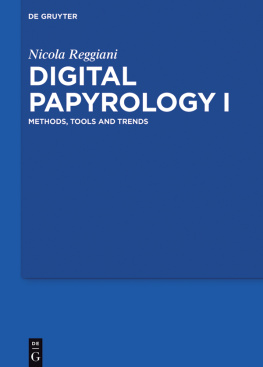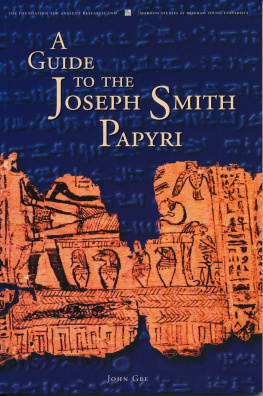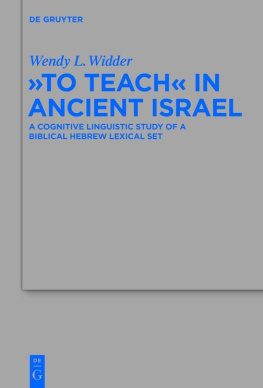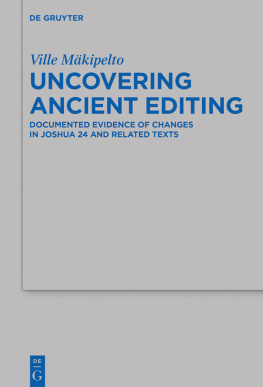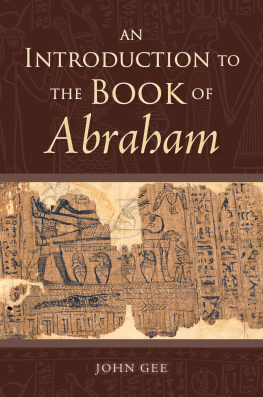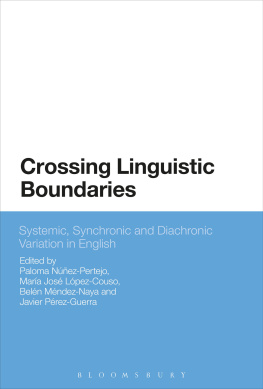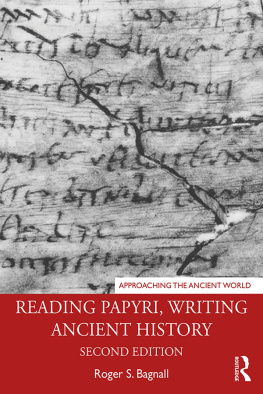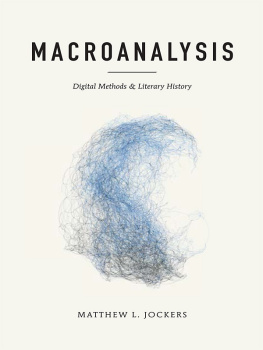Contents
Guide

Digital Papyrology II
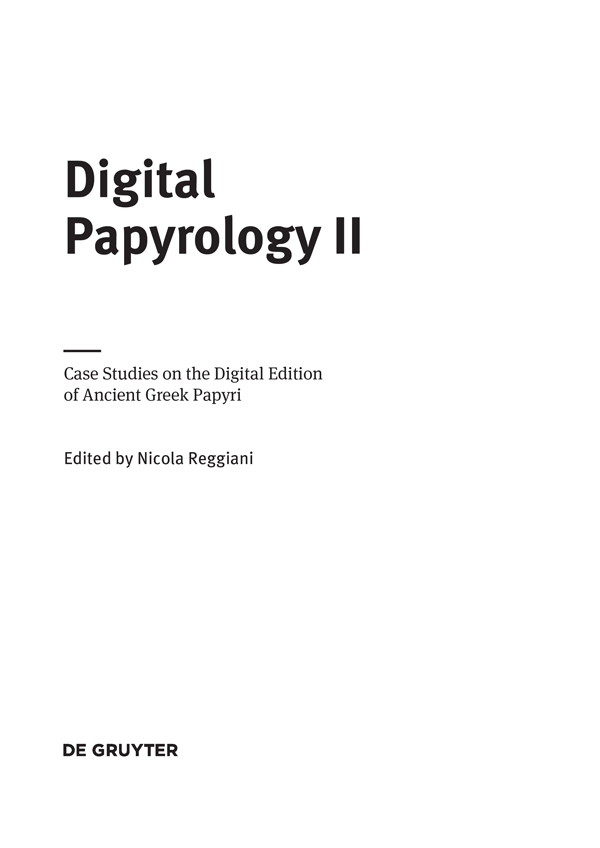
The present volume is published in the framework of the Project Online Humanities Scholarship: A Digital Medical Library Based on Ancient Texts (DIGMEDTEXT, Principal Investigator Professor Isabella Andorlini), funded by the European Research Council (Advanced Grant no. 339828) at the University of Parma, Dipartimento di Lettere, Arti, Storia e Societ.
ISBN 978-3-11-053852-6
e-ISBN (PDF) 978-3-11-054745-0
e-ISBN (EPUB) 978-3-11-054759-7

This work is licensed under the Creative Commons Attribution-NonCommercial-No-Derivatives 4.0
License. For details go to https://creativecommons.org/licenses/by-nc-nd/4.0/.
Library of Congress Control Number: 2017299846
Bibliographic information published by the Deutsche Nationalbibliothek
The Deutsche Nationalbibliothek lists this publication in the Deutsche Nationalbibliografie;
detailed bibliographic data are available in the Internet at http://dnb.dnb.de.
2018 Nicola Reggiani, published by Walter de Gruyter GmbH, Berlin/Boston
The book is published with open access at www.degruyter.com.
www.degruyter.com
Foreword
The present collective volume is conceived of as the ideal continuation of my monograph Digital Papyrology , which indeed appeared as Volume I with the same publisher. The two volumes are part of a project initially named Beyond the Apparatus intended to frame past and current issues surrounding the digital tools and methods that are being applied to papyrological research and scholarship. In the monograph, I tried to sketch the general outlines of electronic resources (bibliographies and bibliographical standards, metadata catalogues, virtual corpora, word lists and indexes, digital imaging processes, digital palaeography, information media, quantitative analyses, integrated workspaces, textual databases) in an attempt to define Digital Papyrology as a self-standing discipline that deals with meta-papyri, i.e. papyrus texts in the digital space. Accordingly, I argued that the ultimate purpose of Digital Papyrology is the digital critical edition of papyrus texts. The goal of the present volume is precisely to investigate this purpose, from the multifaceted viewpoints of the most advanced trends and projects in the field: namely, the deployment of platforms suitable for the encoding of proper digital critical editions of both documentary and literary Greek papyri and the development of quantitative analysis methods for the evaluation of the linguistic features of the texts.
In this challenge, I owe gratitude to my international colleagues and friends who have enthusiastically accepted to contribute with their invaluable experience in the field: in a rigorous alphabetical order, Rodney Ast (Heidelberg), one of the leaders of the Digital Corpus of Literary Papyri (whom I wish to thank for a linguistic revision of this Preface); Lajos Berkes (Berlin), member of the Papyri.info editorial board and author of several born-digital editions of documentary papyri; Isabella Bonati (North-West University, Pochetsfroom, South Africa), soul of the lexicographical project Medicalia Online ; Giuseppe Celano (Leipzig), co-editor of The Ancient Greek and Latin Dependency Treebank , with his long-standing experience in treebanking and morphological annotation of classical texts; Holger Essler (Wrzburg), DCLP partner and architect of digital projects about linguistic annotation (the Annotated Philodemus ), image alignment and automated character recognition in the Herculaneum papyri ( Anagnosis ); Massimo Magnani (Parma), who kindly agreed to bring a brilliant classical philologists viewpoint to the evaluation of the issue at stake; Joanne Stolk (Ghent), co-editor of the Trismegistos database of Text Irregularities , with her strong experience in linguistic variation in the papyri and its digital treatment; Marja Vierros (Helsinki), who launched (and manages) the pathbreaking platform Sematia aimed at facilitating linguistic annotation of the papyri.
On my side, I wish to acknowledge the fact that the volume stems from the project Online Humanities Scholarship A Digital Medical Library of Ancient Texts (DIGMEDTEXT: http://www.papirologia.unipr.it/ERC), funded by the European Research Council (Advanced Grant Agreement no. 339828) at the University of Parma (20142016) and directed by Professor Isabella Andorlini, to the grateful memory of whom this volume is dedicated. This statement is not a matter of pure bureaucracy. The DIGMEDTEXT project, primarily aimed at creating a database of the Greek medical texts on papyrus, has been the breeding ground for more general theoretical, methodological, and technical reflections about linguistic papyrological phenomena and their electronic treatment, as well as about the digital critical edition of the papyri themselves. It is my hope that the entire papyrological community, and in general all scholarship interested in such topics, will enjoy the results reached in the past years, and that discussion and development may continue further in the future.
Parma, January 10, 2018
Nicola Reggiani

Part 1: Platforms Between Theory and Practice
Nicola Reggiani
The Corpus of the Greek Medical Papyri and a New Concept of Digital Critical Edition
The present contribution is published in the framework of the Project Online Humanities Scholarship: A Digital Medical Library Based on Ancient Texts (DIGMEDTEXT, Principal Investigator Professor Isabella Andorlini), funded by the European Research Council (Advanced Grant no. 339828) at the University of Parma (http://www.papirologia.unipr.it/ERC).
1Defining and shaping a digital critical edition
Traditionally and basically, a critical edition of a text is the printed output of a philological work, i.e. the process of reconstruction of a textual archetype (the source) among different variants, aimed at reproducing the original text as most exactly as possible, or, in other terms, as the fixed representation of a scholars more or less trustable opinion on that text. Accordingly, and rather intuitively, a digital critical edition should be defined as the digital output of a philological work. We will see what a digital output involves in methodological and epistemological terms but, to start, it must be noted that traditionally a digital critical edition is regarded as the digital transfer of a printed critical edition. Sometimes, this process regretfully gets rid of the attribute critical, so that we have digital editions or textual corpora deprived of apparatus criticus and therefore uncritical, as in the well-known cases of the Thesaurus Linguae Graecae or of the Perseus Digital Library . This treatment presents encoding advantages, since one reference edition is chosen and digitized, but also huge disadvantages in terms of usability, because search and analysis functions are limited to the chosen text, without consideration, e.g., for textual variants, alternatives or different editorial solutions. apparatus of print-like format, stressing the distance between the correct text and alternatives, variants, actual textual features.


